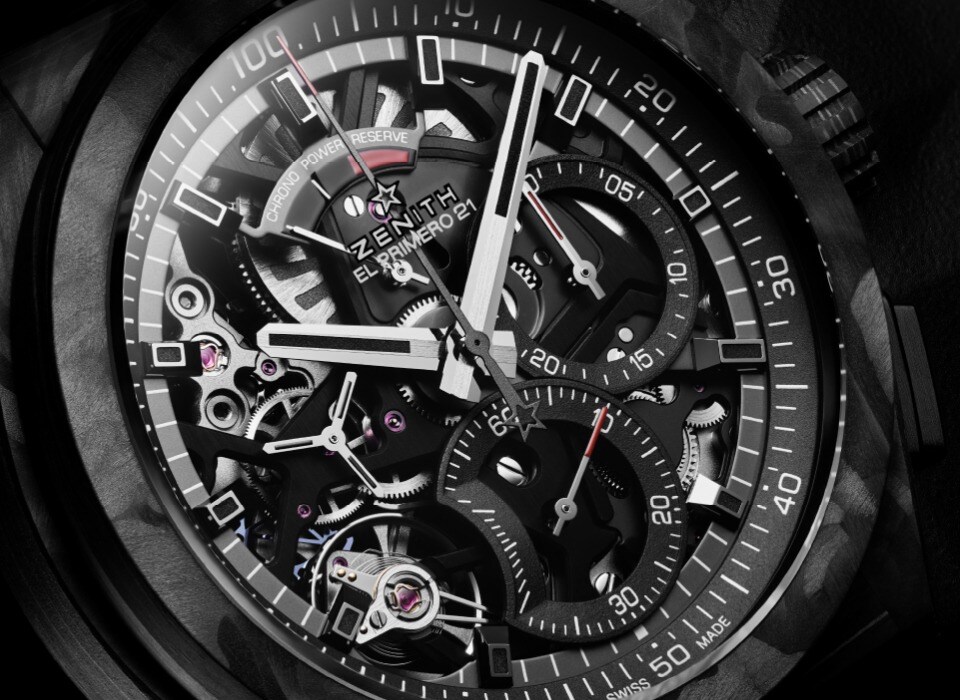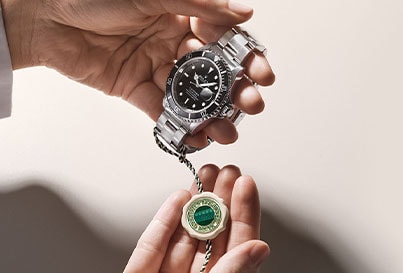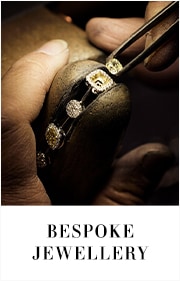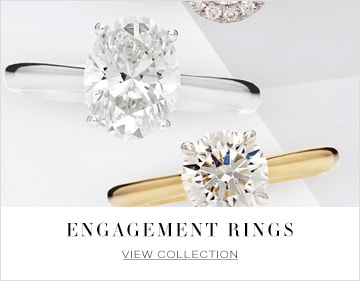-
Watches
By Category
Anytime. Anywhere.
By Collection
By Brand
-
Rolex
By Category
By Collection
- Rolex Certified Pre-Owned
- Pre-Owned & Vintage
-
Brands
Watch Brands
Jewelry Brands
-
Jewelry
By Metal
By Gemstone
By Collection
By Brand
-
Engagement
By MetalBy StyleBy Cut/ShapeBuild Your Ring
-
Wedding
By MetalWedding JewelryEditorial
- Sale
-
Sell Your Watch
Sell Your Watch
We will expertly assess your watch and offer you
a competitive and accurate valuation for the
watch you wish to sell to us.Free valuation by our experts
Unrivalled knowledge & expertise
Competitive prices offeredBrands we buy
A. Lange & SohneAudemars PiguetBlancpainBreguetBreitlingCartierIWC SchaffhausenJaeger-LeCoultreLonginesOMEGAPatek PhilippeRolexHeuerTudorVacheron Constantin - Stores
- Shop by Category
-
Watches
- Back
- Shop All Watches
- By Category
- Anytime. Anywhere.
- By Collection
-
By Brand
- Rolex
- Angelus
- Arnold & Son
- Berd Vay'e
- Blancpain
- Bovet
- Breitling
- BVLGARI
- Cartier
- DOXA
- Girard-Perregaux
- Grand Seiko
- Hamilton
- Hublot
- ID Genève
- IWC Schaffhausen
- Jacob & Co
- L’epee 1839
- Longines
- Luminox
- Nivada Grenchen
- OMEGA
- Oris
- Panerai
- QLOCKTWO
- Rado
- Raymond Weil
- Reservoir
- Speake Marin
- TAG Heuer
- Tissot
- Tudor
- Ulysse Nardin
- William Wood Watches
- WOLF
- Zenith
- Rolex
- Rolex Certified Pre-Owned
- Certified Pre-Owned
-
Brands
- Back
- View All Brands
-
A-Z
- Rolex
- Angelus
- Arnold & Son
- Berd Vay'e
- Bijoux Birks
- Blancpain
- Bovet
- Breitling
- BVLGARI
- Carlex
- Cartier
- CHANEL
- Di Modolo
- Dinh Van
- DOXA
- FOPE
- Girard-Perregaux
- Goshwara
- Grand Seiko
- Gucci
- Hamilton
- Hearts on Fire
- Hublot
- ID Genève
- Ippolita
- IWC Schaffhausen
- Jacob & Co
- J Fine
- L’epee 1839
- Longines
- Luminox
- Mappin & Webb
- Marco Bicego
- Massena LAB
- Mayors
- Messika
- Mikimoto
- Nivada Grenchen
- Nouvel Heritage
- OMEGA
- Oris
- Panerai
- Parmigiani Fleurier
- Paul Morelli
- Pasquale Bruni
- Penny Preville
- Persée
- Pomellato
- QLOCKTWO
- Rado
- Raymond Weil
- Reservoir
- Roberto Coin
- Royal Asscher
- Serafino Consoli
- Speake Marin
- Tabayer
- TAG Heuer
- Tissot
- Tudor
- Ulysse Nardin
- Uneek
- William Wood Watches
- WOLF
- Zenith
- Jewelry
- Engagement
- Wedding
- Sale
- Sell Your Watch
- Stores
- My Account
- Wishlist
- Store Finder
- Request an Appointment
- Help & Support
Horological Complications: Part I
By Watches of Switzerland Group | 6 minute read

Purchasing a watch can be a complex process, from deciding which brand to go for, to choosing a wealth of case sizes, aswell as a wide choice of materials and straps to select from. On top of all that, you may want to decide what you need in terms of functionality. Do you go for a solid chronograph complication? What’s the difference between an annual calendar and a perpetual calendar mechanism? And what’s the purpose of a moon-phase display? These are all common questions watch buyers ask themselves, which is why we’ve put together this handy guide to horological complications. In part I, you’ll learn all you need to know about chronographs, GMT watches, world-timers and calendar watches.
Back to basics
Patek Philippe describes a complication in watchmaking as ‘anything a mechanical watch might do beyond telling the time and simple date’. However, most other sources believe that even a date window is a complication, simple though it may be. In essence, a watch complication could be described as any feature on your timepiece that goes beyond telling the time. Given that rather sweeping definition, you’ll be unsurprised to hear that there are a lot of watch complications to get your head around. From the practical, such as a chronograph or a world-timer, to the more charming and romantic, such as a moon-phase or minute repeater, the horological world has developed many incredible features over the centuries. So which one suits you best? In this guide, we’re going to look at complications that could help you in everyday life.
Stopping time: the chronograph
For the sportier adventure-seekers among us, being able to stop and start time is incredibly useful, be it for timing a lap of the pool or the racetrack. That’s where the chronograph comes in.
The very first pocket-watch chronograph was actually invented in 1816 by a watchmaker named Louis Moinet, but it wasn’t until 1821 that the chronograph got its name when another French watchmaker, Nicolas Mathieu Rieussec, developed a mechanism for timing horse races. This instrument dropped a small amount of ink on the dial to mark the elapsed time (in Greek, ‘chronos’ means time and ‘graph’ means writing). Different iterations of the chronograph followed, and in 1913, Longines created the first wrist chronograph for timing horse races (if its early advertisements are anything to go by). These early chronographs only had one button, which was used to start, stop and reset the timer.
However, in 1915, Gaston Breitling, son of Breitling’s founder Léon Breitling, invented one of the world’s first wrist chronographs with a separate pushpiece (a fancy word for a button) above the crown. In 1923, he went further, developing a patented pocket watch with two chronograph pushers: one at 2 o’clock for starting and stopping the chronograph, and the other integrated into the crown to reset the chronograph mechanism. This meant that, for the first time, a stopwatch could measure multiple times in sequence.
Today the chronograph, whether hand-wound or automatic is the most popular complication for a fast-paced lifestyle and can measure duration to a fifth, tenth or even hundredth of a second. You can easily recognise a chronograph watch as it usually features a series of three sub-dials. These days, most of us have a stopwatch app on our smartphone, but there’s still something wholly satisfying about timing events using a chronograph watch and, for that reason this complication is one of the most popular ones out there.
Crossing time zones: the GMT
If you travel regularly for work, a GMT watch always proves its worth. These watches first appeared during the golden age of jet travel in the 1950s, when airlines such as Pan Am and British Airways (then known as BOAC) began flying non-stop from cities like London and New York to far-flung destinations like Johannesburg. Suddenly, people could cross oceans and multiple time zones, all in a day. Despite the glamour, Pan Am pilots found keeping track of the time in another city perplexing, so the airline approached Rolex to create a watch that could track the time in the departure city and at the destination.
In 1955, Rolex answered the call with the GMT-Master, featuring its now signature red-and-blue ‘Pepsi’ bezel. The watch could track two time zones simultaneously thanks to a second GMT hour hand pointing to a 24-hour time scale on the rotating bezel. As the bezel could be turned, any hour could be set to correspond with the GMT hand — thus tracking the second time zone as well as home, or local, time. Today’s GMT watches can generally be divided into two categories: the first has an independently adjustable GMT hand, which can be set separately from local time and the date; and the second links the GMT hand to the minute hand while the normal hour hand is independently adjustable and is linked to the date.
A world of difference: the world-timer
For committed travellers, and those who love a map, there’s the world-timer. These watches show the wearer the hour pretty much anywhere in the world – at a glance. Early models closest to the world-timer watch we know and love today were first developed by Louis Cottier in the 1930s and 40s. These featured a 24-hour ring mounted in the centre of the dial that could be rotated anti-clockwise and read in relation to an outer cities ring — often the latter was fixed, although occasionally this outer ring could be rotated and operated by a second crown.
Today, world-timer models from the likes of Patek Philippe and Vacheron Constantin tend to follow Cottier’s example, although some, such as Montblanc’s, have jazzed up the complication further with exquisite maps on the dial. Either way, they’re perfect for seasoned travellers, or for those looking for a charming watch design.
Social engagements: the annual calendar, the perpetual calendar and the complete calendar
Calendar watches can be a little tricky to wrap your head around. Put simply, there are three types, each with different levels of complexity: the complete calendar, the annual calendar and the perpetual calendar.
The complete calendar, sometimes referred to as the full calendar, essentially displays the day, date, month, time and, sometimes, the phases of the moon on the dial. These watches are beautiful to look at, but they’ll need to be reset whenever there are fewer than 31 days in a month. As a result, complete calendars are widely seen as the entry-level variant of this highly sought-after and expensive complication.
Like the complete calendar, both the annual calendar and the perpetual calendar watch display the hour, day, date, month and moon-phase. Both are based on the Gregorian calendar, but the main difference is that an annual calendar must be set manually once a year, while the perpetual calendar automatically adjusts itself, even from February 28th or February 29th to March 1st. Incredibly, a perpetual calendar, or quantième perpetual, often doesn’t need to be adjusted until the year 2100, and only then because of an irregularity to the date rather than any issue with the complication: Pope Gregory’s calendar determines that 2100 will not be a leap year (as is the case with three ‘century’ years out of four). For sheer complexity, the perpetual calendar stands as one of the pinnacles of haute horlogerie.





